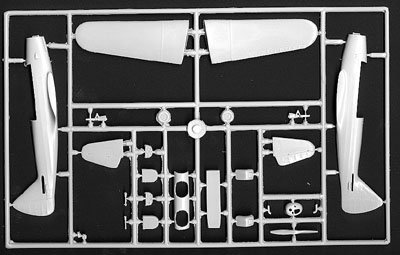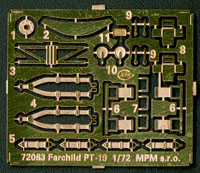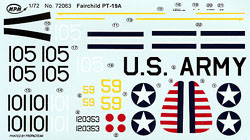MPM 1/72 Fairchild PT-19A
By Chris Banyai-Riepl
 |
|
The Fairchild PT-19, like the Ryan ST-A, was designed to be an easy-to-fly trainer for both military and civilian services. This two-place open cockpit plane was designed with an unconventional wing that reduced stalls and spins, making it a favorite amongst students and instructors alike. The first flight of the PT-19 took place in 1938, and a year later it won a contract with the USAAC, becoming its primary trainer in 1940. Thousands of PT-19s were made, and by 1944 more USAAC pilots had received their initial training the PT-19 than in any other plane. After the war, many of the PT-19s found their way into civilian hands, where their easy handling and open cockpits helped revive the sport aviation industry. Even today there are PT-19s flying, proving that the Fairchild design was a sound one.
The interior is sparse, much like the real plane. Stringer detail is molded into the fuselage halves, and a cockpit floor, seats, and instrument panels are all provided in plastic. Brass seatbelts, rudder pedals, and trim controls are provided, as are brass The wings are separated into left and right pieces, and are solid. There is no locating tab, so some care will need to be taken to ensure that they are affixed with the proper dihedral and alignment. The tailplanes fit into a notch cut into the tail, so there shouldn't be as much of a problem there. The propeller is one piece, with a brass front hub plate that really sets it off. MPM took care to provide just the right details in brass to take what could have been a mediocre kit and turn it into an excellent one. This attention to details should be commended. The windscreens are vacuformed, and have minimal distortion. A brass rearview mirror is provided as well. Propagteam prints the decals, and two choices are provided both very colorful. The first choice is a Cornell Mk I(the RAF designation for the plane) from "Little Norway" The other option is a more mundane (in comparison) option from the USAAC, featuring the blue fuselage and chrome yellow wings and tail. The standard red/white/blue rudder striping is present, and there are two options available for the national insignia: with the red "meatball" and without. MPM has done a great job of pushing their experience in injection molding to the limits, and then accenting the results with some outstanding etched brass and finishing it off with some incredible decals. Once finished, no matter what marking option you choose this kit will stand out on your shelf. While it is definitely not a kit you can slap together in an afternoon, it is one that looks to be a relaxing build. |

 The MPM kit of the PT-19 emulates the original by being very simple. This doesn't mean there is no detail, though. The representation of the fabric control surfaces and fuselage is simply the best I have ever seen. It is very restrained, and once painted will be a perfect scale replica. There is a little roughness on some of the parts, which is a common problem with the limited run kits coming out of Eastern Europe. A little sandpaper and five minutes are all that's needed there, though.
The MPM kit of the PT-19 emulates the original by being very simple. This doesn't mean there is no detail, though. The representation of the fabric control surfaces and fuselage is simply the best I have ever seen. It is very restrained, and once painted will be a perfect scale replica. There is a little roughness on some of the parts, which is a common problem with the limited run kits coming out of Eastern Europe. A little sandpaper and five minutes are all that's needed there, though. throttles. These are made up of three pieces of brass, two forming the throttle levers themselves and one folding into the control box. This provides a great piece of detail that could not be duplicated in plastic. Just make sure that the front cockpit throttles are positioned the same as the rear cockpit's. The only improvement could have been to provide the instrument panels as brass instead of plastic.
throttles. These are made up of three pieces of brass, two forming the throttle levers themselves and one folding into the control box. This provides a great piece of detail that could not be duplicated in plastic. Just make sure that the front cockpit throttles are positioned the same as the rear cockpit's. The only improvement could have been to provide the instrument panels as brass instead of plastic. (Ontario Airport) in Canada. It is painted in the standard trainer color scheme consisting of a blue fuselage and chromate yellow wings and tail. A yellow cheat line runs down the side of the fuselage, broken only by the white plane number. The rudder is painted red, as are the stripes on the wings. Over these red areas is laid a decal consisting of a white/blue/white stripe, resulting in the Norwegian markings on the tail and wings. This combination of red/white/blue/white/red stripes on a yellow and blue plane will really make this one an eye-catcher!
(Ontario Airport) in Canada. It is painted in the standard trainer color scheme consisting of a blue fuselage and chromate yellow wings and tail. A yellow cheat line runs down the side of the fuselage, broken only by the white plane number. The rudder is painted red, as are the stripes on the wings. Over these red areas is laid a decal consisting of a white/blue/white stripe, resulting in the Norwegian markings on the tail and wings. This combination of red/white/blue/white/red stripes on a yellow and blue plane will really make this one an eye-catcher!